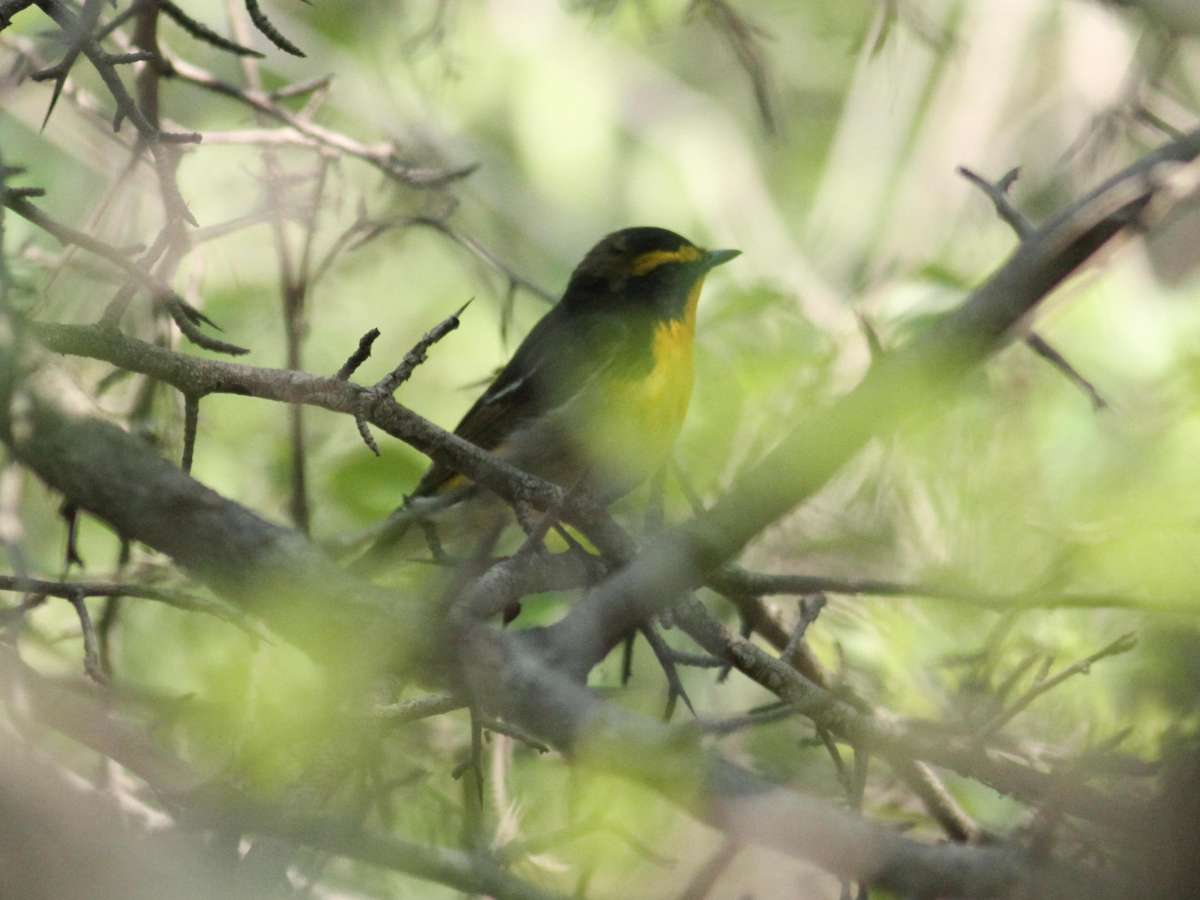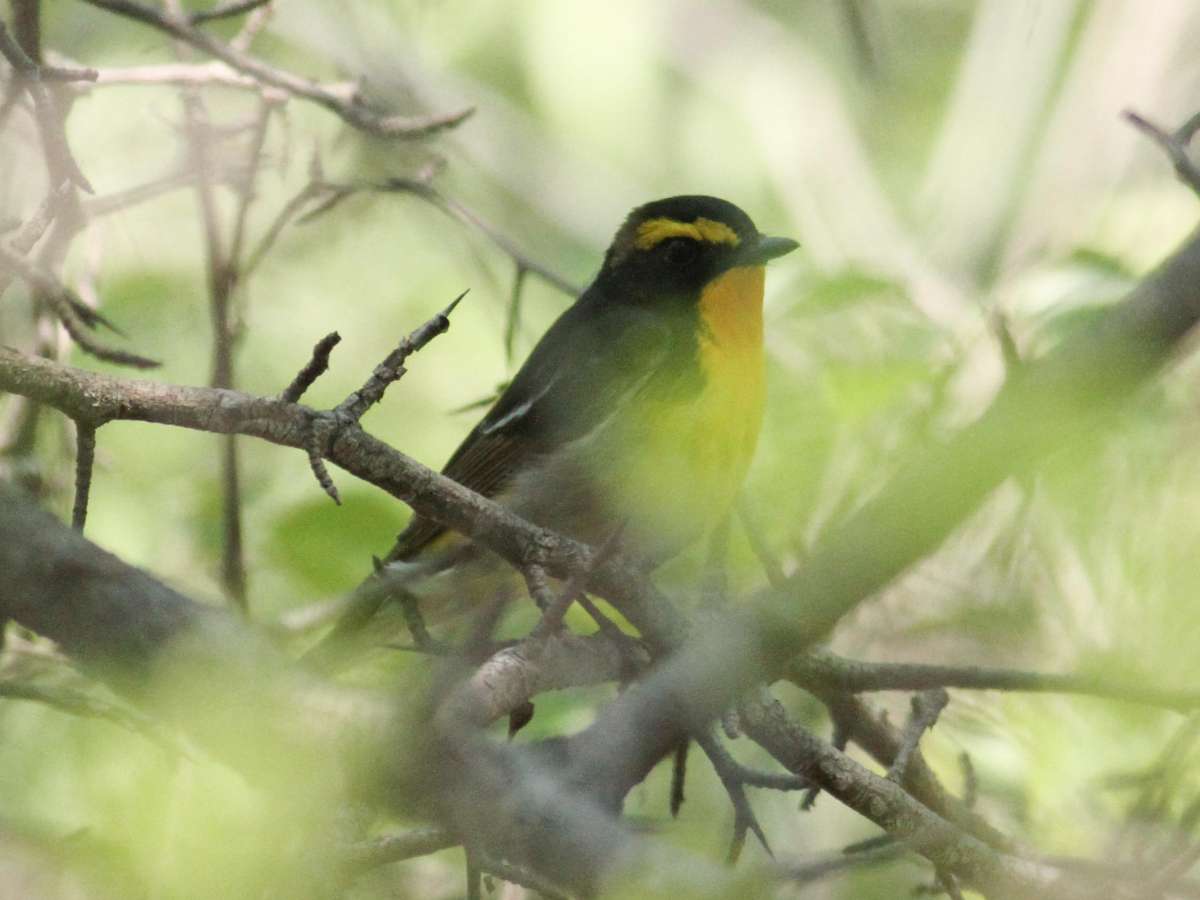[All photographs copyright, Gary Nunn 2015] – I found this first summer male Narcissus Flycatcher Ficedula narcissina on Happy Island, Hebei Province, China on 14 May 2012. I was on a solo visit for ten days to the island and this sighting was a real highlight. So far as I am aware, this species is very rarely seen in China. Buried beneath an overhanging scraggly bush in Temple Wood, I struggled to focus the camera on the flycatcher from my position on the boardwalk. I quickly skipped back to manual focus and hurriedly snapped the two documentation photographs shown below. The flycatcher took off through the woods and was not seen by any other observers, in spite of a British birding tour group just a short distance away! It appears to be a first summer male, retaining some of the first winter grayish feathers about the nape and hind supercilium. Fresh orange yellow feathers are molted into most of the supercilium, and other field marks of the species can be seen such as the black chest side spur, white wingbar, and beautiful fresh looking orange throat and chest. One of the more surprising finds during my ten days on Happy Island.
Category Archives: China
Rufous-tailed Robin, too close – China 2012
Any trip to northeast China in early May has a clutch of species, “megas”, you really want to connect with so badly. Very near the top of my list, skulking forest bird junkie that I am, was Rufous-tailed Robin Larvivora sibilans (formerly known as Luscinia sibilans). I was not planning on leaving without crippling views! My first experience with this “mega” came at the fabled Friendship Hotel, Beidaihe, where I got a distant ‘scope view, briefly, of one deep in the shade of low bushes. As I would find out on many occasions later, this is one heck of a shy bird! My comment at the time, other than the part I am censoring, was BVD – “Better Views Desired”! It was not until I went down to a more recently widely known “migration fallout” location, the so-called “Stone River”, east of Qinhuangdao on the coast, that I finally connected with this jaw-dropper at point blank range.
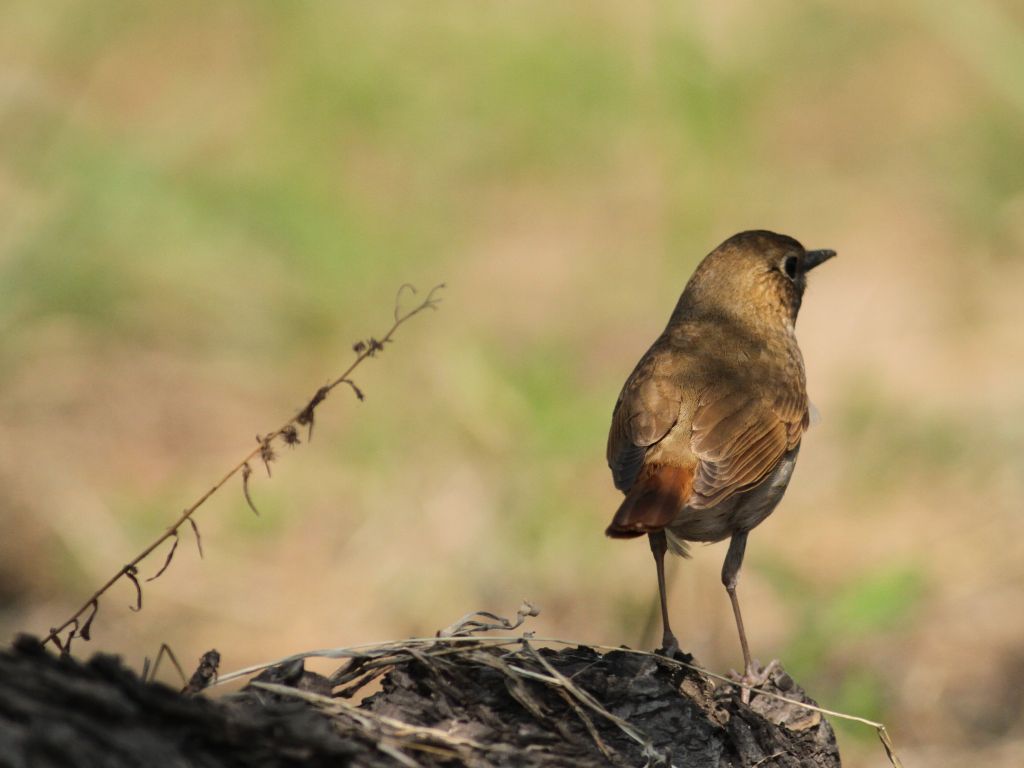 Stone River, a name given by visiting birders, is a boulder and pebble strewn river channel, east of Qinhuangdao, northeast Hebei prefecture, that heads south to the Bohai Sea. The river broadens to a stony-bedded estuary here and contains many small islands attractive to roosting shorebirds and gulls. A dirt road, easy to drive, leaves the highway bridge over the river and skirts the south side of the estuarine river channel about two kilometers before terminating at the sea. This area is a massive quarrying enterprise, fueling the construction industry, but the leftover ponds, channels and depressions provided all manner of waterbird habitats. At the end of the road, abutting the water at a sea defense berm, there were small plantations of manicured pines, none more than five meters high, evidently catering to the booming housing development and landscaping business. These isolated tiny woodlands proved irresistible to migrating passerines and many high quality species could be found here. Top of my day’s birds here was this confiding Rufous-tailed Robin that came almost too close to photograph!
Stone River, a name given by visiting birders, is a boulder and pebble strewn river channel, east of Qinhuangdao, northeast Hebei prefecture, that heads south to the Bohai Sea. The river broadens to a stony-bedded estuary here and contains many small islands attractive to roosting shorebirds and gulls. A dirt road, easy to drive, leaves the highway bridge over the river and skirts the south side of the estuarine river channel about two kilometers before terminating at the sea. This area is a massive quarrying enterprise, fueling the construction industry, but the leftover ponds, channels and depressions provided all manner of waterbird habitats. At the end of the road, abutting the water at a sea defense berm, there were small plantations of manicured pines, none more than five meters high, evidently catering to the booming housing development and landscaping business. These isolated tiny woodlands proved irresistible to migrating passerines and many high quality species could be found here. Top of my day’s birds here was this confiding Rufous-tailed Robin that came almost too close to photograph!
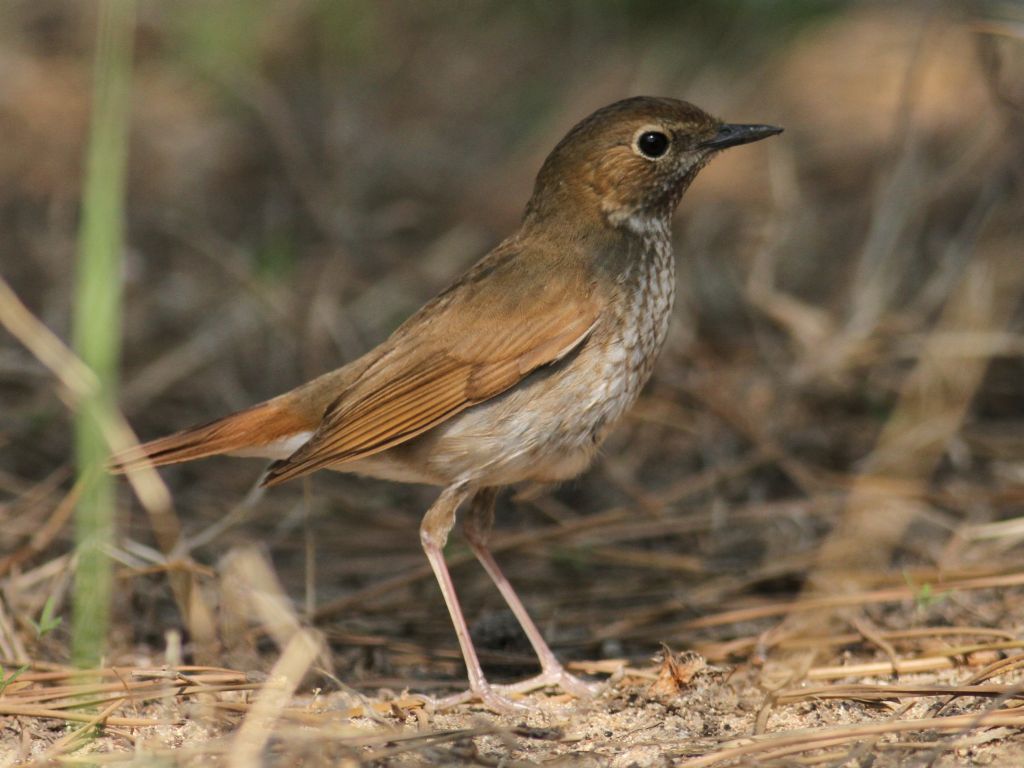 For a long time the Old World robins were considered close relatives of the thrushes, Turdidae, but recent genetic evidence has revealed a strong tie with the Old World Muscicapidae family. A nice summary of the findings about these evolutionary relationships, at least relevant to the Old World species recorded in North America, can be found at the AOU NACC proposal 2010-B for taxonomic name changes made back in 2010. At first glance you can see a resemblance to New World Catharus thrushes such as the Veery C. fuscescens, for which it has been mistaken in Alaska, but study the eye size, with the very bold eye-ring, and those brown haloed chest feathers, and one soon senses this is something different altogether!
For a long time the Old World robins were considered close relatives of the thrushes, Turdidae, but recent genetic evidence has revealed a strong tie with the Old World Muscicapidae family. A nice summary of the findings about these evolutionary relationships, at least relevant to the Old World species recorded in North America, can be found at the AOU NACC proposal 2010-B for taxonomic name changes made back in 2010. At first glance you can see a resemblance to New World Catharus thrushes such as the Veery C. fuscescens, for which it has been mistaken in Alaska, but study the eye size, with the very bold eye-ring, and those brown haloed chest feathers, and one soon senses this is something different altogether!
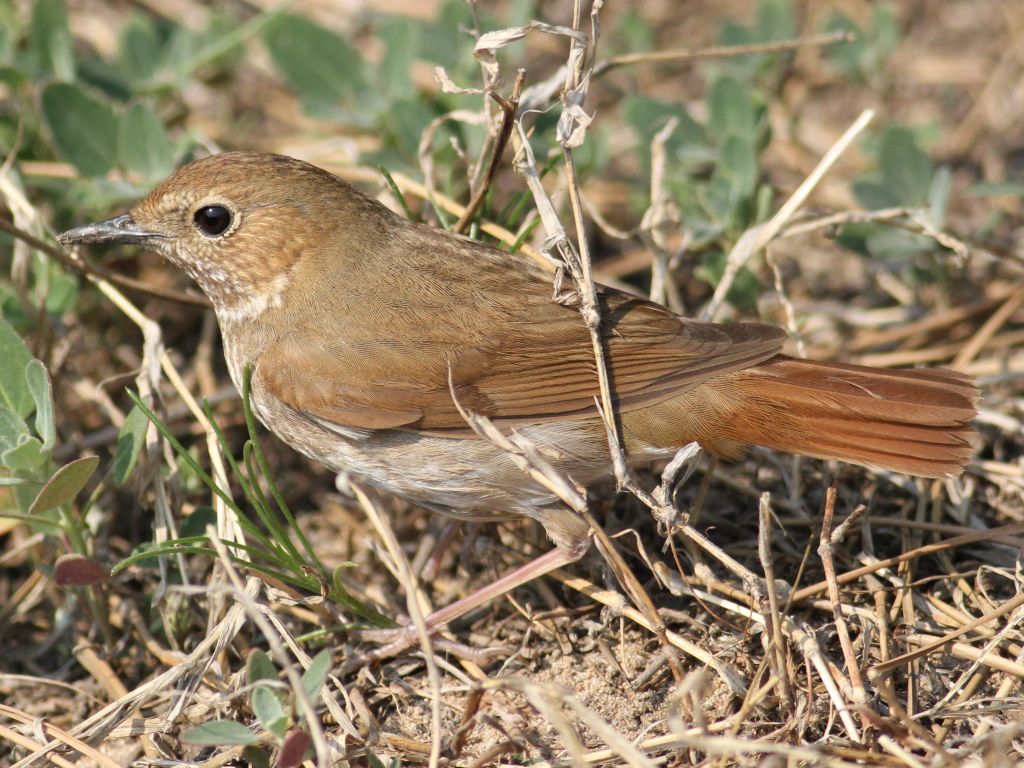 The coastal plantations of small manicured pines proved to be a magnet for migrants. And birds were very easy to pin down for crippling close views. Instead of disappearing into endless larger trees, or low bushes, the birds could only shoot around the back of a small open pine tree. There were no other bushes or long grass to find or lose the bird into. I soon learned to duck low down and locate a bird on the ground, quietly make a way around the pines and epic views were forthcoming. The local Chinese bird photographers evidently knew this area well, carting their big lenses around in gleaming new Toyota Land Cruisers, hitting favored spots with lots of exposed perches. Shrikes, flycatchers, robins, and warblers were over-running the place. If you waited by a perch more birds just kept coming for photo opportunities!
The coastal plantations of small manicured pines proved to be a magnet for migrants. And birds were very easy to pin down for crippling close views. Instead of disappearing into endless larger trees, or low bushes, the birds could only shoot around the back of a small open pine tree. There were no other bushes or long grass to find or lose the bird into. I soon learned to duck low down and locate a bird on the ground, quietly make a way around the pines and epic views were forthcoming. The local Chinese bird photographers evidently knew this area well, carting their big lenses around in gleaming new Toyota Land Cruisers, hitting favored spots with lots of exposed perches. Shrikes, flycatchers, robins, and warblers were over-running the place. If you waited by a perch more birds just kept coming for photo opportunities!
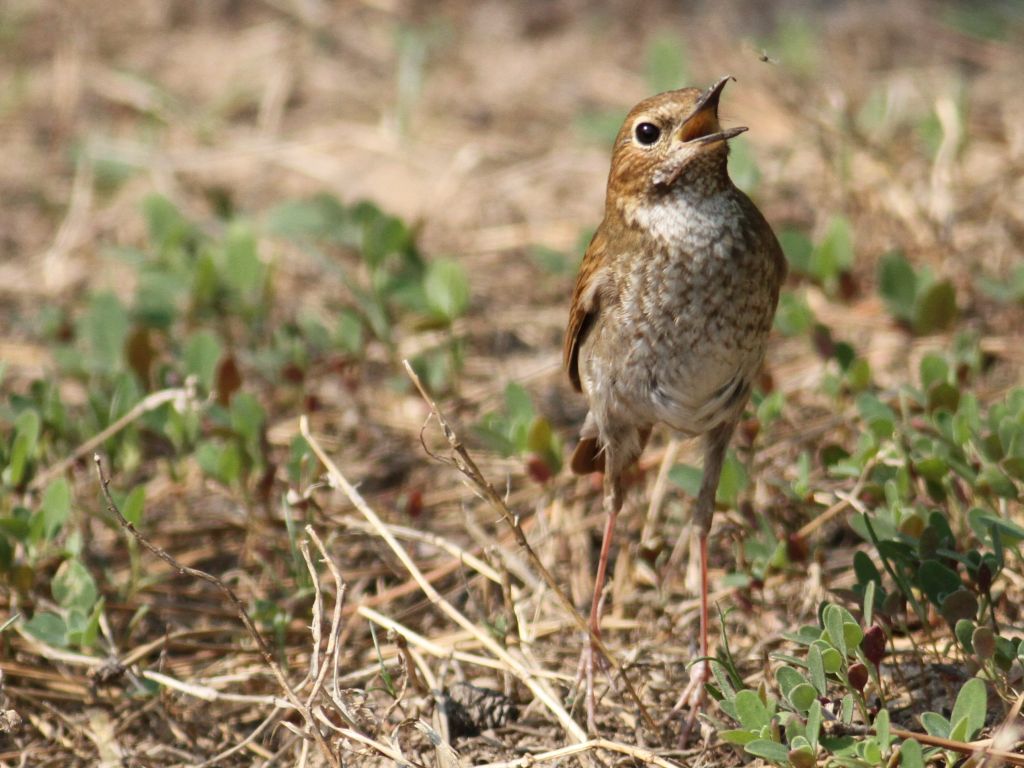 My favorite photograph I only discovered later, putting those huge legs into action the bird leaps up to snatch the tiniest flying gnat! This photograph shows well the pattern of underparts coloration, a whitish bib and belly patch, darker colored throat and breast sides, and those amazing, and unique, haloed brown fringes to the chest feathers. One of my best experiences from a very successful trip to China.
My favorite photograph I only discovered later, putting those huge legs into action the bird leaps up to snatch the tiniest flying gnat! This photograph shows well the pattern of underparts coloration, a whitish bib and belly patch, darker colored throat and breast sides, and those amazing, and unique, haloed brown fringes to the chest feathers. One of my best experiences from a very successful trip to China.

